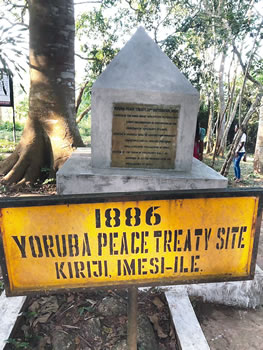Kiriji War Site

Kiriji War Site
Kiriji War was fought among the Yorubas of the South Western Nigeria on the land of Igbajo on one side and Imesi-lle on the other.
The Kiriji peace pact was signed on 23rd September 1886 between the leaders of Ekiti Parapo and the Ibadans’. To seal the treaty, two giant “Peregun” trees were planted at the site: One on Ibadan side and the other at Ekiti side.
The people celebrate the remembrance of Kiriji War peace treaty during September annually.
“Kiriji” itself is an onomatopoeia word, which echoes the sound and vibration of war guns. The war was fought on Igbajo and Imesi-lle land.
Notable Features within the Kiriji Peace Treaty Site Include
- The peace treaty monument on which thedetails of agreement of the peace treaty is inscribed.
- The peregun trees which still exists to denote the spot of agreement, which settled the quarrel etc.
Kiriji War Zone and Peace Treaty Site
The historic war axis is located at the territories of both Imesi-Ile, Obokun Local Government and Igbajo, Boluwaduro Local Government.
Yoruba Kiriji wars was an epic and chronic civil war between two powerful confederate armies of mainly western Yorubas (Ibadan and its allies) and eastern Yorubas (Ijesas and Ekitis). The war showcased the largest array of military hardware in west Africa. It is on record that the Eastern Yoruba confederacy purchased a large number of Canon guns which produced the thunderous sound Kiriji. Therefore, came the word Kiriji.
The Site is an historical and economic asset to the State and the Yorubas in general.
The Site has some historical and symbolic Spots allied to it, as follows:

Ogedengbe Seat and Stool, Ekitiparapo /Ijesa Camp Imesi-Ile

Fejeboju Stream, Ekitiparapo /Ijesa Camp Imesi-Ile;
At the epic of the dreaded Kiriji war, many causalities were recorded at both sides. From the end of the Ekiti-Parapo soldiers, wounded soldiers with bullets rushed to this stream to wash-off the blood and relieved from the pain. The stream eventually turned bloody. Thereafter, anybody with bullet wound would get to the river to clean –up, hence, in the dialect of Imesi-Ile ‘’ FEJEBOJU’’

Kiriji Peace Treaty Site, Ekitiparapo /Ijesa Camp Imesi-Ile;
To end the war, a cenotaph of twelve (12) Peace Treaty articles was signed on the 23rd of September, 1886 by the Governor of Lagos State with his Commissioner Henry Ingis and Oliver Smith, alongside his interpreter Rev. Johnson. The two cenotaphs mark the signing of the Peace Treaty between the Ibadan and EkitiParapo. There exist two ‘’Peregun trees’’. (Trees of life) each at Ibadan and Ijesa directions
Uses and Potentials
- Tourism and Recreation
- Wildlife Conservation
- Ideal spot for filming
- Religious activities
- Education and Research
Ogun and Blacksmith Sites, Ekitiparapo /IjesaCamp,Imesi-Ile,
Faragbota Mysterious Tree, Ibadan Allied Solders Camp, Igbajo;Faragbota Tree Camp: Kiriji war was very deadly with bullets flying around like swamp of bees. Whenever, there were fire powers of the enemies, soldiers wound hide behind the Faragbota Tree, as shelter. It was a mysterious tree that absorbed bullets from the enemies. The potency of the tree and how it absorbed bullets brought out the name FARAGBOTA TREE. The original FARAGBOTA TREE had died and rotten, but mysteriously another tree sprouted from it.

IbudoLatoosa Camp, Ibadan Allied Soldiers Camp, Igbajo.

Faragbota Tree CampIgbajo:
Kiriji war was very deadly with bullets flying around like swamp of bees. Whenever, there were fire powers of the enemies, soldiers wound hide behind a mysterious tree as a shelter. The mysterious tree absorbed bullets from the enemies. The potency of the tree and how it absorbed bullets brought out the name FARAGBOTA TREE. The original FARAGBOTA TREE had died years ago, and rotten, but mysteriously another tree sprouted from it. The Site located in Igbajo, Boluwaduro Local Government area of the State has historical, cultural-tourism and economic values.

Kiriji War Site
Kiriji War was fought among the Yorubas of the South Western Nigeria on the land of Igbajo on one side and Imesi-lle on the other.
The Kiriji peace pact was signed on 23rd September 1886 between the leaders of Ekiti Parapo and the Ibadans’. To seal the treaty, two giant “Peregun” trees were planted at the site: One on Ibadan side and the other at Ekiti side.
The people celebrate the remembrance of Kiriji War peace treaty during September annually.
“Kiriji” itself is an onomatopoeia word, which echoes the sound and vibration of war guns. The war was fought on Igbajo and Imesi-lle land.
Notable Features within the Kiriji Peace Treaty Site Include
- The peace treaty monument on which thedetails of agreement of the peace treaty is inscribed.
- The peregun trees which still exists to denote the spot of agreement, which settled the quarrel etc.
